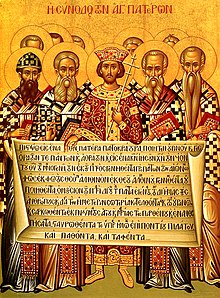User:Renamed user g175ah9zh46atga576/sandbox
The Roman-Persian Wars[edit]
Lasting from 92BC to 627AD the conflict between the Persian and Roman Empires was a protracted struggle which was arguably a continuation of the Greco-Persian Wars. The Roman-Persian Wars led to weakening of the neighboring Arab states to the South and East of the Byzantine Empire. The conflict so drained both the Persian and Byzantine empires that once the conquests of Muhammad started, neither could mount an effective defense against the onslaught. Persia fell to the Arabs (see conquests).
Byzantine-Arab Wars[edit]
Following the death of Muhammad in 632, there was a vigorous push by the Arabs to conquer Arab tribes of the East such as the mostly Christian Ghassanids. The Byzantine-Arab Wars were a series of wars between the Arab Muslims Caliphates and the Eastern Orthodox Byzantine Empire. These started during the initial Arabic conquests under the Rashidun and Umayyad caliphs and continued in the form of an enduring border tussle until the beginning of the Crusades.
The initial conflict lasted from 629-717, ending with the Second Arab Siege of Constantinople that halted the rapid expansion of the Umayyad dynasty into Asia Minor. Conflicts with Arabs however continued between the 9th century and 1169. The Arab victories resulted in the Byzantine emperor Alexios I Komnenos request for military aid from Pope Urban II at the Council of Piacenza in 1095; one of the events often attributed as a precursor to the First Crusade.
The earliest forms of Christianity were Greek as ecclesiastical historian Henry Hart Milman (1791–1868) writes: "For some considerable (it cannot but be an undefinable) part of three first centuries, the Church of Rome, and most, if not all the Churches of the West, were, if we may so speak, Greek religious colonies. Their language was Greek, their organization Greek, their writers Greek, their scriptures Greek; and many vestiges and traditions show that their ritual, their Liturgy, was Greek."[1]
Modern Ecumenism[edit]

Modern Ecumenism between different Orthodox groups of the Mideast is a long and evolving process, as referenced by mention in this article of the very active Ecumenist movement between the Oriental Orthodox and the Eastern Orthodox, as well as the recent reconciliation between the Patriarch of Moscow and ROCOR (see Act of Canonical Communion with the Moscow Patriarchate), and the very active communication between Rome and Roman Catholicism and the Orthodox communities.
In 731[2] or 733[3] or by 740, Leo III attached Illyricum and Southern Italy (Sicily and Calabria) to Patriarch Anastasius of Constantinople, transferring the papal authority to the Eastern Church.[4]
Sometimes Patriarchs (often of Constantinople) were deposed by the emperor; at one point emperors sided with the iconoclasts in the 8th and 9th centuries.[citation needed]
- ^ Greek Orthodox Christianity
- ^ Fine 1991, p. 116
- ^ A collection of dated Byzantine lead seals, page 47: "733... Church of Constantinople"
- ^ Treadgold, Warren (1997). A History of the Byzantine State and Society. Stanford: University of Stanford Press. pp. 354–355. ISBN 0-8047-2630-2.

